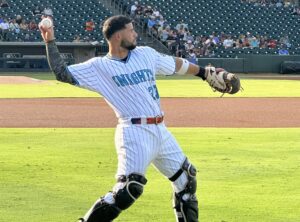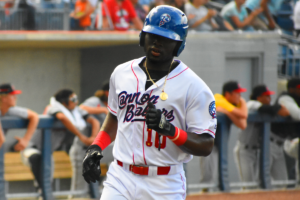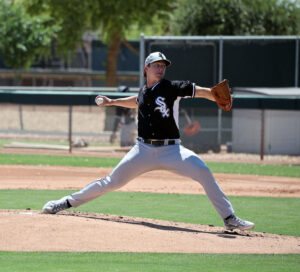Brave New World: White Sox Enter the Realm of Biomechanics
When most organizations undergo massive change in the form of a rebuilding process as foreign and complex as the Chicago White Sox have, the primary decision makers usually don’t withstand. Chris Sale was traded in the winter of 2016 and a new direction was forged. Atypical to the rest of the industry, Ken Williams and Rick Hahn lived to eulogize that time period in the history of the franchise.
While the figures at the very top of the organization remained the same, the organization as a whole is different in many areas. Mike Shirley is the new Director of Amateur Scouting. His predecessor, Nick Hostetler, occupies an unspecific role in pro scouting and reports directly to the General Manager. Many other changes to the player development staff have taken place. The club saw the addition of more scouts on the ground as well, which is also a deviation from much of the industry.
Farm Director Chris Getz has seen the makeup of his department change substantially as well. Everett Teaford is the organization’s new Director of Pitching, while Ben Broussard takes over as the Director of Hitting.
INFORMATION RETENTION
Speaking during a Soxfest seminar recently, Getz reiterated that the new hires were intended to prioritize the retention of consumed information by professionals with effective communication processes. Teaford has been doing similarly already. Broussard is a seven-year major league veteran, adept at communicating and equipped with modern hitting practices after serving as the organization’s Leadership and Development Coordinator in 2019.
Ryan Johansen is another employee whose stock is ascending within the Chicago White Sox organization. Johansen runs Johansen Baseball out of St. Charles, IL, and served as the assistant hitting coach with the Kannapolis Intimidators last year. 2020 will be his first season as the Assistant Hitting Coordinator for the entire organization.
His expertise is respected as evidenced by this recent profile piece published at Sox on 35th. Johansen’s influence has seemingly led to broader change in the development model. Assistants with similar backgrounds in biomechanics have been added to affiliates. This includes Devin DeYoung’s arrival in Birmingham and the addition of colleague Nate Pearson in a quality control role.
PREVENTION AND PERFORMANCE
Ben Hansen has consulted for the White Sox in the recent past, but recently started working for the club exclusively. Hansen is now the Senior Biomechanical Engineer of the Chicago White Sox. He will no longer be advancing the processes of the other 29 teams filtering throughout the sport. When asked to explain the reasoning for the addition, Getz stated that Hansen will help with “injury prevention and performance improvements.”
Hansen added that “the role is focused on applying principles of biomechanics to player health and performance. As an engineer, there will be a large focus on software and algorithm development from raw sensor and camera data captured on players.”. He is currently working out of the new technology room stationed in Glendale, Arizona, inside the facilities located at Camelback Ranch.
“This can come in the form of insights to help players move better or train smarter through workload management and software development,” explains Hansen. He will be working closely with the medical and training staff, in addition to on-field personnel such as Teaford and Broussard.
MORE THAN MOTUS
Hansen previously served as the Vice President of Biomechanics and Innovation for Motus Global in St. Petersburg, Florida. Baseball is a passion of Hansen’s and his creative mind wasn’t willing to accept the old axiom that faulty form is the sole reason for arm injuries among pitchers.
The reason for this was simple: personal experience. In 2006, Hansen was pitching for his high school baseball team. This new frontier of information wasn’t yet prevalent in the game. Hansen went on to pitch in college for the Milwaukee School of Engineering, but he battled injuries, including the partial tear of the ulnar collateral ligament in his right elbow. The injury forced him to miss an entire season.
Motus Global is a startup company that produces wearable sports technology. Pitchers of all ages are using Motus technology to improve performance, prevent injuries and better understand the human body while doing so.
In 2015, Motus Throw was developed as the first wearable for baseball. It is a compression sleeve with a sensor that tracks the motion of a pitchers arm. It’s been reported that by 2019, dozens of major league teams were using Motus technology for training and rehabilitation. Motus also uses consumer grade sensors perfected for smartphones to gather biometric data related to an athlete’s ultimate workload.
EARLY ADOPTION
The New York Yankees and Houston Astros were exploring swing biomechanics as early as 2015. They used Ben Hansen and Motus Global to fit minor league players with motion-capture markers to track body mobility during a specific movement or swing analysis. The data was then analyzed to project players into the future.
A biomechanical equivalence model helped project batting average, slugging percentage, isolated power, K/AB, HR/AB, line drive rates and ground ball rates in baseball players. A group of teams has been cutting edge in regards to using similar practices while — in turn — being out ahead of the industry.
“It was a new data source,” says Ben Hansen. “It was a way of thinking that wasn’t really available before. To project a player with that was very intriguing, both from identifying talent early on in your own organization, but also from talent procurement in other sources.”
Data from Motus also indicates that it’s accumulated workload on a player’s muscles and ligaments that cause injuries like UCL tears.
The Yankees and Astros have built their own biomechanics departments after initially using Hansen and Motus Global in the earlier part of the decade. Many other forward thinking organizations have been ahead of the curve in this regard as well. There are some teams that needed to be nudged into the 21st century. The White Sox were long considered to be a bit of an ‘old school operation’.
It can be argued that the organization as a whole is still behind the eight ball in regards to modern practices. Still, the changes in player development mirror the structure designed by some of the very best organizations in the sport. The Chicago White Sox appear to be on the right track at least, and not afraid to dip their toes into the changing landscape.
THE NEW FRONTIER
Matt Lisle served as a Hitting Analytics Instructor for the White Sox in 2019, but his services weren’t renewed for the 2020 season. The responsibilities Lisle had were always guarded like trade secrets by the organization, so those responsibilities are still unknown.
The hiring screamed that the organization was headed into a new data driven world. However, that specific role and person ultimately weren’t the preferred fit. At the end of the last minor league season, Lisle announced that he’d be moving on from the club in what was assumed to be a firing.
Lisle is considered to be the ‘internets most well-known baseball and softball hitting coach’ due to his story and development of The Hitting Vault. Whether it was a misconstrued communication technique or perceived abrasiveness as the reasons for a change, Lisle is now the hitting coach for Fresno State girls softball instead of working for a major league club. The White Sox might be in a better place today though, because of some of the knowledge imparted by Lisle or conduits in a similar capacity.
TOOLS ON THE RISE
K-vests and rapsodos littered the spring training fields in Glendale last February. The latest concoctions will likely be on display over the next few months as well. K-vests are fitted around a player’s chest and worn under a baseball uniform or athletic gear. They are a significant tool that records objective kinematic data that helps find the truth when the eye-test can be deceiving.
The rapsodos were used heavily on the pitching side to help players determine an ideal pitch design and proper practices in regard to tunneling. The devices were first deployed in golf and are very helpful to read pitch flight analysis in baseball. Rapsodos can be used to design optimal swings and interpret exit velocity, launch angle and spin axis accurately as well.
These are only some of the tools that Ben Hansen will be able to use with the White Sox. His position as a biomechanical engineer isn’t one that is commonplace in the industry necessarily, but it’s a growing trend.
“This type of role is growing in baseball,” said Hansen. “As biomechanics data becomes more accessible from cameras and sensors, teams are learning that this data can be valuable for player development, player scouting and player rehabilitation. When I was with the Brewers 10 years ago, very few teams had access to motion capture like we did then. Today, nearly every team employs some form of motion capture and player analysis.”
STRIVING FOR BETTER DEVELOPMENT
Hansen’s experience should be positive in aiding the scouting and development processes that the organization is attempting to achieve. Blast motion and trackman data have been prevalent methods of data retrieval for the organization of late.
Blast motion is sensor-based swing analysis that can be auto-edited into video clips and uploaded into easily accessible phone applications for the players to consume. Trackman captures comprehensive and accurate ball tracking data during games or practices. The technology is intended to eliminate guesswork in player evaluation and development.
The use of force plates to measure how players are pressing their feet into the ground during swings, and correlating it to bat speed, is something that the organization is presently doing. It’s another area in which Hansen’s department can work in conjunction with Broussard, Johansen and the rest of the development staff.
PREP TRENDS
It should also help establish clear benchmarks and data points in amateur scouting. Instead of an over-reliance on Trackman data from college stadiums, Hansen’s arrival could further accelerate the processes towards continuing the recent trend of adding prep talent to an organization previously primarily attached to college prospects.
The addition of a biomechanical engineer can help the medical and training staff with injury prevention as well. Hansen states that, “technology now exists that allows for constant and long-term recording of a pitcher’s arm motion, which lets players track and understand the stress on their bodies”.
Pitcher health and player availability was a strength of the White Sox’s organization for much of the last 20 years. In recent vintage, the injuries have piled up however, especially with pitchers and the epidemic of Tommy John surgery. Player health is another area in which constant tweaks to the status quo could be a boon for the club going forward.
IN-HOUSE DEVELOPMENT
Similarly to their peers in the industry, the White Sox have the capability of developing their own projection models internally to aid in player health and performance based on biomechanics. Ben Hansen came to the White Sox with the belief that the organization is “positive and forward thinking.”
When questioned on that assertion, Hansen surmised that, “Having worked with many MLB organizations over the last 8 years through Motus’ contracted Biomechanics Lab services and smart compression sleeve, I’ve been exposed to a variety of front office temperaments and mentalities toward biomechanics analytics. The White Sox front office and coaching staff have been one of the most positive groups on this front. I couldn’t be happier to join their team”.
Biomechanics and baseball can be seen as a brave new world for some in a game often reticent towards change. The leap into modernity is a positive step for the Chicago White Sox, and late is better than never.
Want to know right away when we publish a new article? Type your email address in the box on the right-side bar (or at the bottom, if on a mobile device) and click the “Subscribe” button. Our list is completely spam free, and you can opt out at any time. Also, consider supporting FutureSox on Patreon! You can get early access to special articles and Patreon-only posts, in addition to more benefits you can read about here. Shop our exclusive merchandise! Show your support with the latest FutureSox apparel.






